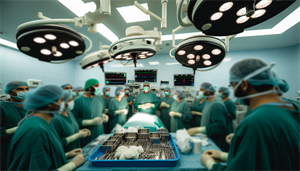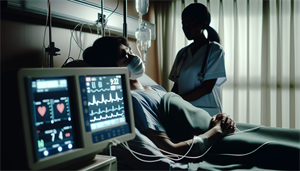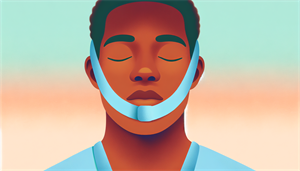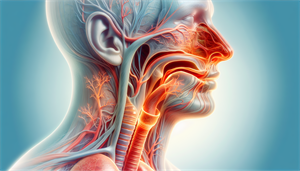If you’re wondering, “can you develop sleep apnea after surgery?” the short answer is yes. Surgery can influence sleep patterns and potentially lead to sleep apnea due to anesthesia, sedation, and stress on the body.
In this article, we’ll explore how surgical procedures might trigger or worsen this condition, and what that means for your postoperative care and recovery.
Key Takeaways
-
Surgical procedures, anesthesia, and sedation can exacerbate or even trigger obstructive sleep apnea (OSAS) by causing alterations in sleep patterns and increasing the likelihood of airway collapse, potentially leading to various complications.
-
Identifying sleep apnea in surgical patients is critical for managing and minimizing perioperative complications, which can be achieved using screening tools like the Berlin, ASA, and STOP-BANG questionnaires, as well as methods like nocturnal pulse oximetry.
-
Proper perioperative management of sleep apnea, including preoperative evaluation, attentive intraoperative care, and rigorous postoperative monitoring, is essential to reduce the risk of complications and improve patient outcomes.
Surgery's Impact on Sleep Apnea Development

Surgery, a routine part of our healthcare landscape, can have an unexpected yet significant impact on the development of obstructive sleep apnea syndrome (OSAS). The connection between the two may not seem apparent initially, but it becomes clearer when we delve into the effects of anesthesia, sedation, and surgical stress on our sleep patterns and breathing. As a result, sleep medicine plays a crucial role in understanding and managing this connection.
Intermittent and recurrent episodes of partial or complete obstruction of the upper airway during sleep are the main features of obstructive sleep apnea, causing breathing pauses and disturbances in sleep patterns. This condition, often referred to as unrecognized obstructive sleep apnea, can lead to symptoms such as:
-
daytime fatigue
-
loud snoring
-
morning headaches
-
difficulty concentrating
-
irritability
-
increased risk of high blood pressure, heart disease, and stroke
Its association with surgical procedures becomes more significant when you consider factors such as anesthesia and surgical stress. It’s not just about the surgery itself; it’s also about the after-effects. Postoperative complications are a major concern, and an increase in their likelihood is a risk we cannot afford to ignore.
Alterations in sleep patterns, such as an initial drop in sleep efficiency, REM sleep, and slow-wave sleep, may occur after surgery. Although these changes are typically temporary, they can potentially exacerbate or even trigger sleep apnea. This is because after surgery, the Apnea-Hypopnea Index, a measure of sleep apnea severity, tends to rise, indicating a potential worsening of the condition.
Anesthesia and Sedation Effects
As fundamental elements of most surgical procedures, anesthesia and sedation can significantly influence sleep apnea. They can exacerbate the condition by increasing the likelihood of airway collapse, which, in turn, can lead to postoperative cardiovascular complications. It’s not just the immediate effects during surgery; the impact extends well into the postoperative period, affecting ventilatory responses and even the arousal response in patients with sleep apnea.
The arousal response, the body’s mechanism to awaken us from sleep in response to threats such as airway obstruction, plays a critical role in sleep apnea patients. Anesthesia, however, can inhibit this response, increasing the risk of prolonged episodes of apnea during sleep.
The effects of anesthesia and sedation on sleep apnea are not isolated; they are part of a broader impact that surgery can have on sleep patterns. Surgical stress, for instance, can lead to disruptions in sleep patterns and a reduction in REM sleep, both of which can further complicate the management of sleep apnea in surgical patients.
Surgical Stress and Sleep Disturbances
Another important aspect of the surgical process, surgical stress, can profoundly affect sleep. It can lead to sleep disturbances and a decrease in REM sleep in patients undergoing major abdominal surgery. These changes in sleep patterns can lead to an increased risk of postoperative complications such as hypoxemia and myocardial ischemia. In this context, understanding abdominal surgery leads and their impact on patients is crucial for medical professionals.
The disturbances in sleep patterns caused by surgical stress are not just about changes in sleep stages. They’re also about hormonal changes. For instance, surgical stress can lead to elevated levels of cortisol, which can notably diminish REM sleep.
The physiological changes that occur in the body as a result of surgical stress are profound and far-reaching. They encompass:
-
Neuroendocrine-metabolic and inflammatory-immune processes
-
Changes in metabolism
-
Pain
-
Perioperative nutrition factors
-
Restricted mobility
-
Sterile inflammation
All these changes have the potential to disrupt regular sleep patterns, thus contributing to the onset or exacerbation of sleep apnea.
Identifying Sleep Apnea in Surgical Patients

Effective management of sleep apnea hinges on its early identification in surgical patients. This identification is not only crucial for reducing the risk of perioperative complications but also for improving patient outcomes. One might wonder, how exactly do we identify sleep apnea in surgical patients?
The answer lies in the use of various screening methods. These include questionnaires and screening tools such as the Berlin, ASA, and STOP-BANG, which can assist in identifying surgical patients with obstructive sleep apnea. Each of these tools has its own unique set of questions and scoring systems. For instance, the Berlin questionnaire for sleep apnea is a self-administered questionnaire that helps evaluate the risk of sleep apnea.
The ASA questionnaire, on the other hand, uses the STOP questionnaire, a succinct and user-friendly tool designed specifically for preoperative clinics in surgical patients. Then there’s the STOP-BANG screening tool, a questionnaire that assesses indicators and risk factors associated with obstructive sleep apnea. A score of 3 or higher on this tool indicates a heightened likelihood of having sleep apnea.
But the identification of sleep apnea in surgical patients doesn’t stop at questionnaires. There are other, more technologically advanced methods as well. One such method is nocturnal pulse oximetry, a method that monitors and records oxygen saturation levels and heart rate during sleep. This method is highly effective in screening obstructive sleep apnea in surgical patients, demonstrating a high level of diagnostic accuracy in predicting moderate to severe sleep-disordered breathing.
Questionnaires and Screening Tools
In identifying sleep apnea among surgical patients, questionnaires and screening tools serve a vital function. These tools, which include the Berlin, ASA, and STOP-BANG questionnaires, provide a systematic way of assessing the risk of sleep apnea in patients. The significance of administering these screening questionnaires cannot be overstated, as they allow for the identification of patients at high risk for obstructive sleep apnea.
The effectiveness of these questionnaires in identifying sleep apnea is backed by empirical evidence. For instance, the Berlin questionnaire has demonstrated a high sensitivity and negative predictive value in detecting surgical patients with moderate-to-severe obstructive sleep apnea.
But the Berlin questionnaire is not the only effective tool. In addition to the ASA questionnaire, the Stop, STOP-BANG (SB), and Epworth Sleepiness Scale (ESS) are also widely acknowledged as effective tools for screening obstructive sleep apnea.
Nocturnal Pulse Oximetry and Home Sleep Testing
Beyond questionnaires, various other methods can help identify sleep apnea in surgical patients. One such method is nocturnal pulse oximetry. This non-invasive diagnostic procedure monitors and records oxygen saturation levels and heart rate during sleep, providing valuable information for assessing the cardiorespiratory condition of individuals with sleep apnea.
Another similar technique is ambulatory monitoring. This method, which includes nocturnal pulse oximetry, is particularly useful for evaluating patients who are at a high risk for sleep apnea and coronary artery disease.
The effectiveness of these methods in diagnosing sleep apnea cannot be understated. Nocturnal pulse oximetry, for instance, has demonstrated significant effectiveness in diagnosing sleep apnea in surgical patients, offering valuable insights into their cardiorespiratory status. Moreover, ambulatory monitoring, such as nocturnal pulse oximetry, has demonstrated the ability to validate the diagnosis of OSA in a significant number of adult surgical patients identified as high risk prior to their surgeries.
Perioperative Management of Sleep Apnea

The process of managing sleep apnea extends beyond its identification. There’s a whole process of perioperative management that comes next. This process involves preoperative evaluation, intraoperative care, and postoperative monitoring, all aimed at reducing complications and improving patient outcomes.
The importance of preoperative evaluation in the management of sleep apnea lies in the identification of patients with known obstructive sleep apnea or at high risk for sleep apnea before surgery. This allows for a targeted management plan and appropriate perioperative care to minimize complications.
Intraoperative care involves several factors, including:
-
Careful management of the airway
-
Ensuring adequate preoxygenation and apneic oxygenation
-
Potentially utilizing CPAP or oral appliances for patients accustomed to these modalities.
Postoperative management, the final step in the perioperative management process, involves:
-
Ensuring lateral or semi-upright positioning of the patient
-
Effective pain control while limiting opioid use due to the risk of respiratory depression
-
Judicious fluid management
All these measures are crucial in managing sleep apnea in surgical patients.
Preoperative Evaluation and Planning
In the perioperative management of sleep apnea, preoperative evaluation is indispensable. It involves the identification of high-risk patients and the formulation of management plans for them during the perioperative period.
The process of preoperative evaluation involves a detailed history and physical examination. It is important to gather details such as:
-
Snoring
-
Excessive daytime sleepiness
-
Witnessed apneas
-
Frequent awakenings at night
-
Morning headaches
-
Neck circumference
-
Body mass index
-
Modified Mallampati score
-
Tongue volume
-
Tonsillar size
-
Nasopharyngeal characteristics
Once the high-risk patients have been identified, a specific action plan is put in place for their management during the perioperative period. This action plan includes:
-
Close monitoring of vital signs and symptoms
-
Frequent assessments and evaluations
-
Collaboration with other healthcare professionals
-
Tailored interventions and treatments
-
Timely communication and coordination
This action plan is crucial in minimizing the risk of complications and ensuring the best possible outcomes for the patients.
Intraoperative Care and Considerations
In the perioperative management of sleep apnea, intraoperative care is another critical component. The main objectives of intraoperative care are to minimize surgical stress and duration, to evaluate the advantages of regional anesthesia, and to guarantee that patients are extubated in a semi-upright position.
The reduction of surgical stress and duration has the potential to decrease perioperative complications and alleviate the severity of sleep apnea symptoms, thereby enhancing the patient’s overall quality of life. On the other hand, extubating sleep apnea patients in a semi-upright position is advantageous as it contributes to increased lung volume and ventilation, reduces the likelihood of postoperative upper airway obstruction, and promotes improved tolerance for the endotracheal tube.
In addition to these primary objectives, other factors also need to be considered during the intraoperative care of sleep apnea patients. These include:
-
Implementing general strategies such as lateral or semi-upright positioning
-
Ensuring effective pain management
-
Exercising cautious fluid administration
-
Being mindful of the heightened susceptibility to opioid-induced respiratory depression and altered pain perception.
Postoperative Monitoring and Management
The perioperative management process culminates with postoperative management. It involves:
-
Close monitoring of the patient in the post-anesthesia care unit (PACU)
-
Ensuring the patient is positioned non-supine
-
Minimizing the use of opioids and benzodiazepines
-
Considering the use of dexmedetomidine
-
Possibly using auto-CPAC
The PACU offers immediate postoperative interventions, monitors for complications such as hypoxemia, and ensures continuous care during the patient’s stay. The position of the patient is also crucial. Maintaining postoperative sleep apnea patients in a non-supine position, such as upright or semi-upright, can assist in reducing upper airway obstruction and enhancing sleep apnea symptoms.
The use of dexmedetomidine and auto-CPAP in postoperative management plays a significant role. Dexmedetomidine is utilized to:
-
Enhance the quality of sleep
-
Administer sedation
-
Enhance pharyngeal collapsibility
-
Preserve dilator muscle function.
Auto-CPAP offers the following benefits:
-
Variable pressure range that automatically adjusts to provide patients with appropriate pressure settings each night
-
Enhances sleep quality
-
Decreases snoring
Treatment Options for Sleep Apnea After Surgery

After the completion of the surgical procedure and stabilization of the patient, attention turns to postoperative treatment options for managing sleep apnea. These treatment options play a crucial role in improving sleep quality and reducing complications associated with sleep apnea.
One primary intervention for obstructive sleep apnea (OSA) is continuous positive airway pressure (CPAP) therapy. This therapy is frequently employed in the management of postoperative sleep apnea and has proven efficacy in addressing this condition. Moreover, the use of CPAP after surgery has been linked to reduced postoperative complications and enhanced outcomes.
But CPAP therapy is not without its side effects. Patients using CPAP therapy may encounter:
-
Skin irritations and rashes
-
Nasal congestion
-
Claustrophobia
-
Facial breakages
-
Conjunctivitis
-
Aerophagy
-
Discomfort while breathing
-
Dry mouth
For patients who cannot tolerate CPAP therapy or prefer other treatment options, there are alternative treatments available. These include:
-
Bariatric surgery
-
Positional therapy
-
Auto-titrating positive airway pressure
-
Serotonin agents
-
Wake promoting agents
-
Genioglossus
-
Uvulopalatopharyngoplasty
-
Glossectomy
-
Orthognathic surgery
-
Lifestyle measures
-
Hypoglossal nerve stimulation
-
Oral appliance therapy
-
Nasal surgery
Continuous Positive Airway Pressure (CPAP) Therapy
As a primary intervention for obstructive sleep apnea, Continuous Positive Airway Pressure (CPAP) therapy utilizes a CPAP machine to deliver gentle air pressure. This pressure prevents the airways from collapsing during sleep, thereby helping to alleviate the symptoms of sleep apnea.
CPAP therapy has been shown to have positive effects on postoperative adverse events, oxygenation improvement, decreased need for reintubation and mechanical ventilation, as well as favorable short-term effects on blood pressure. Additionally, the use of CPAP after surgery has been linked to reduced post-operative complications and lower postoperative AHI.
However, like any treatment, CPAP therapy is not without its potential hazards or adverse effects. These may include:
-
Upper airway infections
-
Skin marks
-
Dry nose and mouth
-
Bloating
-
Difficulty falling asleep
-
Nasal congestion
-
Dry mouth
-
Feelings of claustrophobia
Despite these potential side effects, the benefits of CPAP therapy in managing postoperative sleep apnea far outweigh the potential downsides.
Alternative Treatments
For those who cannot tolerate CPAP therapy or prefer alternative solutions, there are other treatments available for sleep apnea, despite CPAP being the primary intervention. One such alternative treatment is electroacupuncture, a procedure that involves the stimulation and adjustment of meridians and collaterals using micropulse current at specific points on the body.
Research has indicated that electroacupuncture exhibits the following properties:
-
Analgesic
-
Sedative
-
Enhances immune function
-
Potential to improve sleep efficacy
-
Prolongs total sleep time in individuals experiencing postoperative sleep disturbances.
Apart from electroacupuncture, environmental adjustments can also be beneficial in treating sleep apnea post-surgery. Minimizing noise and light, for instance, can enhance sleep quality and aid in the recovery process, playing a significant role in the management of sleep apnea following surgery.
Case Studies and Clinical Trials

Despite its complexity, the relationship between surgery, sleep apnea, and perioperative complications has been the focus of extensive research. Case studies and clinical trials provide valuable insights into this intricate relationship, reinforcing the importance of proper identification and management of sleep apnea in surgical patients.
In a systematic review aimed at identifying pertinent studies on the correlation between obstructive sleep apnea and perioperative outcomes, a total of 11 articles were identified. The study, which was conducted as a prospective observational study with no intervention, visually represented patient recruitment and study implementation in a flow chart.
Polysomnography, a method used to record sleep patterns over multiple nights, was employed in the study. Fifty-one patients were recorded over five postoperative nights, and seven patients were recorded over four nights. The study evaluated polysomnography parameters that quantified sleep-disordered breathing.
The insights gleaned from these case studies and clinical trials underscore the significance of understanding the relationship between surgery and sleep apnea. They highlight the need for appropriate management strategies, including effective preoperative evaluation, careful intraoperative care, and meticulous postoperative monitoring and management.
Summary
The journey from surgery to recovery is a complex one, made even more intricate by the interplay of sleep apnea. From the impact of surgery on the development of sleep apnea to the importance of identifying sleep apnea in surgical patients, each step of the journey holds significant implications for patient outcomes. With the right management strategies, including preoperative evaluation, intraoperative care, and postoperative monitoring, the risks associated with sleep apnea can be effectively mitigated.
The road to recovery doesn’t end at surgery. The postoperative period, marked by the need for targeted interventions and treatments, is just as crucial. While CPAP therapy remains the primary intervention for obstructive sleep apnea, alternative treatments like electroacupuncture and environmental adjustments offer additional avenues for managing sleep apnea post-surgery. Through a comprehensive understanding of sleep apnea and its relationship with surgery, we can pave the way for improved patient outcomes and a smoother road to recovery.
Frequently Asked Questions
Can sleep apnea be caused by surgery?
Yes, sleep apnea can be worsened by surgery due to the use of sedation, anesthesia, and opioids during the perioperative period, which can increase pharyngeal collapse and impair the arousal response.
Can anesthesia make sleep apnea worse?
Yes, anesthesia can make sleep apnea worse by suppressing upper airway muscles, reducing breathing, and decreasing oxygen levels, which can be dangerous for people with sleep apnea. It can also impair the arousal response, a protective defense mechanism against sleep apnea.
Can sleep apnea just develop?
Yes, anyone can develop obstructive sleep apnea, but certain risk factors such as excess weight can increase the likelihood of developing it.
How to treat sleep apnea?
To treat sleep apnea, possible treatments include conservative approaches, positive airway pressure devices, oral appliances, nerve stimulators, surgery, and in some cases, medications for central sleep apnea. In addition, healthy lifestyle changes such as regular physical activity, maintaining healthy sleep habits, managing weight, limiting alcohol and caffeine, and quitting smoking can be very effective.
What is involved in the perioperative management of sleep apnea in surgical patients?
The perioperative management of sleep apnea in surgical patients involves preoperative evaluation, intraoperative care, and postoperative monitoring and management. It is important to address sleep apnea at each stage of the surgical process for optimal patient outcomes.


